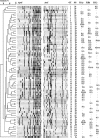Occurrence, Persistence, and Contamination Routes of Listeria monocytogenes Genotypes on Three Finnish Dairy Cattle Farms: a Longitudinal Study
- PMID: 29222098
- PMCID: PMC5795088
- DOI: 10.1128/AEM.02000-17
Occurrence, Persistence, and Contamination Routes of Listeria monocytogenes Genotypes on Three Finnish Dairy Cattle Farms: a Longitudinal Study
Abstract
The molecular epidemiology of Listeria monocytogenes was investigated in a longitudinal study of three Finnish dairy farms during 2013 to 2016. A total of 186 bulk tank milk (BTM), 224 milk filter sock (MFS), and 1,702 barn environment samples were analyzed, and isolates of L. monocytogenes were genotyped using pulsed-field gel electrophoresis. L. monocytogenes occurred throughout the year in all sample types, and the prevalence in MFS increased significantly during the indoor season. L. monocytogenes was more prevalent in MFS (29%) than in BTM (13%) samples. However, the prevalence of L. monocytogenes varied more between farms in samples of MFS (13 to 48%) than in BTM (10 to 16%). For each farm, the L. monocytogenes genotypes detected were classified by persistence (defined as persistent if isolated from ≥3 samples during ≥6 months) and predominance (defined as predominant if >5% prevalence on at least one farm visit). The prevalence of sporadic genotypes was 4 to 5% on all three farms. In contrast, the prevalence of persistent predominant genotypes varied between farms by 4% to 16%. The highest prevalence of persistent predominant genotypes was observed on the farm with the poorest production hygiene. Persistent predominant genotypes were most prevalent on feeding surfaces, water troughs, and floors. Genotypes isolated from the milking system or from cow udders had a greater relative risk of occurring in BTM and MFS than genotypes that only occurred elsewhere in the farm, supporting the hypothesis that L. monocytogenes is transmitted to milk from contamination on the udder surface or in the milking equipment.IMPORTANCEListeria monocytogenes is a ubiquitous environmental bacterium and the causative agent of a serious foodborne illness, listeriosis. Dairy products are common vehicles of listeriosis, and dairy cattle farms harbor L. monocytogenes genotypes associated with human listeriosis outbreaks. Indeed, dairy cattle farms act as a reservoir of L. monocytogenes, and the organism is frequently detected in bulk tank milk (BTM) and in the feces of clinically healthy cows. The ecology of L. monocytogenes in the farm environment is complex and poorly understood. Isolates of the same L. monocytogenes genotype can occur in the farm for years, but the factors contributing to the persistence of genotypes on dairy farms are unknown. Knowledge of the persistence patterns and contamination routes of L. monocytogenes on dairy farms can improve management of the contamination pressure in the farm environment and aid in the development of focused control strategies to reduce BTM contamination.
Keywords: food safety; listeriosis; milk hygiene; molecular epidemiology; persistence.
Copyright © 2018 American Society for Microbiology.
Figures


References
-
- Lundén J, Tolvanen R, Korkeala H. 2004. Human listeriosis outbreaks linked to dairy products in Europe. J Dairy Sci 87:E6–E12. doi:10.3168/jds.S0022-0302(04)70056-9. - DOI
Publication types
MeSH terms
Substances
LinkOut - more resources
Full Text Sources
Other Literature Sources
Medical
Molecular Biology Databases

